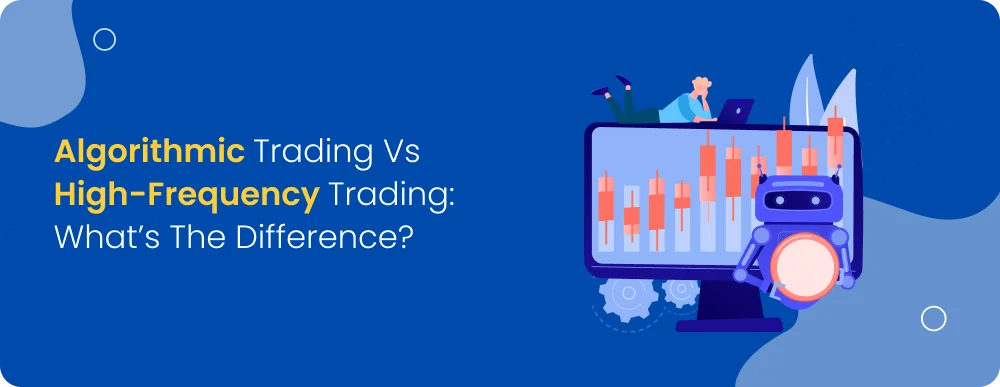Difference Between High-Frequency Trading and Algorithmic Trading
Noor Kaur
30 Jul 2025Tags:
Featured
Algorithmic trading and high-frequency trading (HFT) both use automated systems to execute trades, but they differ in speed, strategy, and infrastructure. While algorithmic trading focuses on rule-based execution over various timeframes, HFT is a specialised subset that relies on ultra-fast systems to exploit small price movements in milliseconds.
Understanding the difference helps you choose the right approach based on your goals, capital, and technical setup.
What Is Algorithmic Trading?
Algorithmic trading is the use of computer programs to place trades automatically based on predefined rules. These rules can be as simple as moving average crossovers or as advanced as trading using AI or machine learning for algorithmic trading. The goal is to reduce human error, speed up execution, and act on strategies consistently.
Step-by-Step Breakdown:
Define a Trading Strategy: Use indicators, price action, or custom logic to outline your rules.
Code the Strategy: Write the logic using tools like Algo Trading in Python or other languages.
Backtest the Strategy: Test it on historical data to see if it would have worked.
Run in Simulation or Live: Start in a demo environment. If stable, go live with a small capital.
Monitor and Optimise: Continuously track performance and adjust as needed.
What Is High Frequency Trading (HFT)
High-frequency trading (HFT) is a specialised form of algorithmic trading focused on executing thousands of trades in fractions of a second. It uses HFT algorithms that rely on ultra-low latency, co-located servers, and real-time market data to exploit micro-opportunities in price movements.
Step-by-Step Breakdown:
Identify Micro-Level Opportunities: Focus on inefficiencies like bid-ask spreads, arbitrage gaps, or order book imbalances.
Develop HFT Algorithms: Code extremely fast logic using low-level languages like C++ for execution speed.
Set Up Infrastructure: Use co-location (servers near the exchange), fibre-optic cables, and high-speed networks.
Test in Real-Time Environments: Run latency-sensitive testing to avoid slippage or execution delay.
Deploy with Monitoring: Monitor all trades live, with risk controls to auto-stop if abnormal patterns occur.
Key Differences - Algorithmic Trading vs HFT
Algorithmic trading and high-frequency trading (HFT) are often used interchangeably, but they aren’t the same. Both involve using computers to execute trades based on pre-set logic, but they differ in purpose, speed, infrastructure, and complexity.
Here's a clear comparison to help you understand the key distinctions between the two:
Aspect | Algorithmic Trading | High-Frequency Trading (HFT) |
Definition | Automated trading based on pre-defined rules or strategies | A subset of algorithmic trading focused on ultra-fast execution |
Speed | Speed is important, but not critical | Microsecond-level speed is essential |
Trade Frequency | Executes fewer trades over longer timeframes (minutes to days) | Executes thousands of trades in seconds |
Strategy Examples | Moving average crossovers, mean reversion, arbitrage, momentum | Market making, arbitrage, order-book imbalance exploitation |
Infrastructure Needs | Standard trading platform or cloud-based systems | Advanced infrastructure with co-location and low-latency networks |
Coding Skills | Helpful, especially with algo trading in Python or R | Required; often involves C++, low-level APIs, and system optimisation |
Users | Retail traders, brokers, institutions | Mostly proprietary firms, hedge funds, and institutional players |
Technology Use | May or may not involve AI algorithmic trading or machine learning for algorithmic trading | Often uses AI/ML and HFT algorithms for edge and speed |
Capital Requirement | Lower, accessible to retail investors | Very high, including infrastructure and regulatory compliance costs |
Latency Sensitivity | Moderate | Extremely sensitive to even microsecond delays |
Risks and Challenges - Algorithmic Trading vs HFT
While both algorithmic trading and high-frequency trading offer speed and automation, they also come with distinct risks, such as:
Risks in Algorithmic Trading
Strategy Overfitting: Backtested strategies may look perfect on historical data but fail in real-time markets due to overfitting.
Execution Errors: Inaccurate price feeds, misconfigured order logic, or faulty code can lead to unintended trades.
Model Drift in AI Strategies: AI algorithmic trading and machine learning for algorithmic trading can degrade over time if models aren't retrained with new data.
Regulatory Risk: Algorithmic trades must follow exchange rules on order placement, quantity, and timing. Violations can lead to penalties.
Over-Reliance on Indicators: Many trading algorithms examples use technical indicators that can fail in volatile markets, causing wrong signals.
Risks in High-Frequency Trading (HFT)
Latency Sensitivity: Even a microsecond delay in order execution can cause losses. Requires constant investment in infrastructure.
Infrastructure Failures: Any glitch in low-latency systems, such as co-location servers or fibre-optic lines, can disrupt trades.
Market Impact: High-speed trading can move prices unintentionally if the volume is too large or the order flow is too aggressive.
Complex Debugging: HFT algorithms are highly optimised and complex, making errors difficult to identify and correct in real time.
Flash Crashes: Errors in logic or rapid-fire orders can contribute to sudden market crashes, especially when liquidity is thin.
High Entry Barrier: High-speed trading requires large upfront capital, specialised talent, and constant tech upgrades, making it risky for underprepared firms.
Regulations in India - Algorithmic Trading vs HFT
SEBI (Securities and Exchange Board of India) has introduced strict regulations to monitor the growth of algorithmic trading and high-frequency trading in India. The aim is to maintain market fairness, prevent manipulation, and protect investors, especially in high-speed, automated environments.
While both fall under the same regulatory umbrella, the rules differ based on how strategies operate and the kind of infrastructure used.
Regulations for Algorithmic Trading in India
Mandatory Exchange Approval: All trading algorithms offered by brokers to clients must be approved by the exchange before use.
Log Maintenance and Transparency: Brokers must maintain detailed logs of every algorithm used. These logs are reviewed to monitor compliance and trace any unusual activity.
White Box vs Black Box Algorithms: SEBI has classified algorithms into two categories:
White box: Transparent and customisable by the trader.
Black box: Proprietary and closed-source logic.
Regulations for High-Frequency Trading (HFT) in India
Co-Location Regulations: SEBI has restricted unfair access to co-location services (servers placed close to exchange infrastructure) to create a level playing field for non-HFT participants.
Order Tagging Requirement: Every order generated by an HFT algorithm must be tagged, enabling post-trade surveillance and data analysis.
Surveillance for Market Abuse: Exchanges are required to run advanced surveillance tools to detect practices like:
Spoofing (placing fake orders to mislead the market)
Layering (using multiple orders to manipulate prices)
Quote stuffing (flooding the market with large orders to create delays)
Strict Penalties for Manipulation: Firms caught misusing HFT algorithms or engaging in manipulative high-speed trading face fines, suspensions, or permanent bans.
Which One is Right for You?
Choosing between algorithmic trading and high-frequency trading (HFT) depends on your goals, capital, technical skills, and access to infrastructure. While both use automation, they serve different trader profiles.
Go for Algorithmic Trading if:
You’re a retail trader or institution focused on strategy-based execution.
You want to automate trades using logic like moving averages, momentum, or breakout setups.
You have basic to intermediate coding knowledge (e.g., algo trading in Python).
You can test and run strategies without needing ultra-low latency or co-location.
You’re exploring AI algorithmic trading or machine learning for algorithmic trading at a manageable scale.
Consider HFT only if:
You’re part of a well-funded firm with access to co-location, low-latency infrastructure, and dedicated servers.
Your team can build and maintain high-performance HFT algorithms using advanced programming (often in C++).
You understand market microstructure deeply and can handle strict SEBI surveillance and compliance.
Your focus is on high-speed trading, market making, or exploiting price inefficiencies in milliseconds.
For most retail and mid-sized traders, algorithmic trading offers more flexibility and lower entry barriers. HFT, on the other hand, is capital-intensive and operationally complex—best suited for institutional participants with deep resources and technical expertise.
FAQs
Is high-frequency trading legal in India?
Yes, high-frequency trading (HFT) is legal in India. It is regulated by SEBI and is allowed on major exchanges like NSE and BSE. However, brokers must meet strict infrastructure and audit requirements, especially for co-location access and high-speed trading systems.
Can retail investors do high-frequency trading?
Retail investors can’t easily access HFT due to its high infrastructure costs and speed requirements. HFT involves co-location servers, direct market access, and advanced high-frequency trading algorithms—features that are typically available to institutional players. However, retail traders can explore other types of trading, like algorithmic trading using slower, rule-based systems.
Do you need coding skills for algorithmic trading?
Yes, basic coding skills are helpful, especially in Python. Many traders use algo trading Python libraries to backtest and deploy strategies. While some platforms offer no-code tools, coding gives you more control to build, test, and modify trading algorithms or even integrate machine learning for algorithmic trading.
How do latency and infrastructure affect HFT performance?
Latency is critical in HFT. Even a few milliseconds can impact order execution and profitability. That’s why HFT firms invest in low-latency networks, co-located servers, and optimised HFT algorithms. Poor infrastructure can cause delays, slippage, or missed trades in high-speed trading environments.
What risks are associated with algorithmic trading?
Algorithmic and AI algorithmic trading carries several risks:
Over-optimisation: A backtested strategy might fail in live markets.
Execution errors: Bugs in the code or poor handling of market conditions can lead to large losses.
Market impact: High volume or speed can affect prices.
Regulatory risk: Non-compliance can lead to penalties or bans.
Is all high-frequency trading algorithmic?
Yes. All high-frequency trading is algorithmic by nature. These trades are executed automatically using HFT algorithms without manual intervention. However, not all algorithmic trading is high-frequency; many strategies operate on slower timeframes and don’t require high-speed trading infrastructure.
Noor Kaur
30 Jul 2025Related blogs


Intraday Trading Strategy: Open High Open Low Approach
Intraday trading is one of the most exciting and rewarding types of online stock trading. As a day trader, you sho...


Understanding NISM Certification : Everything You Need to Know | mastertrust
In today's world, more and more people are getting curious about finance and the world of money. It doesn't matter...


Seeking Better Returns Than FDs? Explore These Options | mastertrust
Fixed deposits are a popular investment choice because of their guaranteed returns and safety.


Role of Inflation in Long-Term Investment Planning
In Financial Planning, one of the things that plays a key role is the impact of inflation on your investments.
Sign up to our newsletter !
Share this article on
Recent articles
Tags:
Open a Demat Account in just 15 minutes !

Click on open
account below

Fill out some
basic details

Upload your
documents

Start trading in
24 Hours *
Commonly asked questions
Is Master Capital Services Limited SEBI registered?
Do you have a mobile app for Trading and Finance Management?
What services does mastertrust provide?
What is the minimum investment required to start trading with your company?
Is my personal and financial information secure with your company?
What is your customer support availability?





